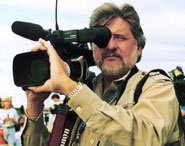 |
→ August 2005 Contents → Welcome
|
Welcome to the August issue of The Digital Journalist, the monthly Web magazine for visual journalism.
One thing that I learned covering presidents over the years for Time magazine is that the month of August always starts off in a languid way. There is the summer heat, people are on vacation and the pace of events slows. Then for some reason, towards the end of the month, all hell breaks loose. George Bush 41 always used to say, "What is it about August?"
We try to take advantage of these quiet days to present work that is not hard-edged. It is time to turn to personal projects: bodies of work that photographers have invested loving care to over years.
At this year's PMA convention, I saw the work by Anne Day, who is best known for her photographs of children. Within those photographs, I was moved by the way her lens had captured feelings that many of us have in common when we think back to the days of summer in our childhood. I asked her if she would create a feature for us on summer. I think she succeeded beyond my fondest expectations. My guess is that as you look at her photographs, you too will be carried back to your memories of childhood.
Barbara Ellison has indulged a lifetime passion for orchids. She and her husband cultivate them in their home near Washington, D.C., and travel around the world finding new species. We present a portfolio of her flowers as a summer feature.
As we write this publetter, New York Times reporter Judith Miller is being held in a jail cell for defending the reporter's duty to protect sources. Meanwhile, Matt Cooper of Time magazine, who was found in contempt by the court at the same time as Miller for doing the same thing, is free. The reason is that without Cooper's knowledge or permission, the Editor-in-Chief of Time, Norman Pearlstein, decided to hand over Cooper's notes. Digital Journalist Executive Editor Peter Howe takes a critical look at how the world's largest newsmagazine has changed, with ever more attention paid to life-style issues and less to the traditional standards of the First Amendment, in his provocative article, "Time Gone By."
This month we present five "Dispatches": two from London, two from Jewish settlements in Gaza and one from Minneapolis. The London pieces reveal the process of photojournalism. The Gaza stories are haunting and set the stage for impending settlement evacuations, while the rodeo images show the power of committed hometown work.
In the mid-1990s, Brian Palmer was a staff photographer for U.S. News & World Report, covering the Clinton White House. He went on to become the magazine's Beijing bureau chief, then to New York to write for Fortune, then on to CNN where he became an on-air correspondent. In his memoir, "From Golden Handcuffs to Stainless Steel Opportunities," he tells us of his journey.
In today's era of photographic digital manipulation, Karen Slattery and Erik Ugland call on publications to take on a uniform standard of full disclosure in their "Ethics" column.
Ron Steinman comments in "Rebuttal" on a recent review by The New York Times' Steven Holden in which he took a cheap shot at TV journalists and cameramen.
With the rise of "citizen journalists," Gina Trapani reviews the new Nokia 7610 cameraphone and the new "lifeblogging" software.
In our video journalism area, Terry Heaton describes how pitting the personal against the professional helps shine a light on one of the great mysteries of our time: why professional media people are so completely ignoring the technologies and concepts that are driving the revolution.
Bill Pierce raises some questions in his "Nuts & Bolts" column about how the venerable Brooks Institute of Photography has come under fire for allegedly giving prospective students promises of big paydays in photography after graduation, and Jim Colburn urges photography students to start saving their work now.
E-Bits editor Beverly Spicer takes on objective reality, manipulation, and interpretation of the photographic medium in examples from political humor to news broadcasts to talking animals, and literally, to hand-painted art.
Mark Loundy offers advice on how to keep your client happy while still protecting your right to display your work to future clients in today's Work for Hire environment.
Chuck Westfall provides more helpful, expert advice to photographers in his Q&A column, "Tech Tips."
The Assignment Sheet has three journals for you this month:
1. "A Tale of Two Fishermen" by Tom Hubbard, Emeritus Professor at Ohio State School of Journalism and Communication, expresses the theme that some news assignments offer greater opportunities to get to know your subjects than others. He relates two, in particular, by two photographers.
2. Joyce Lin's excellent "The Intern" is a must-read for every aspiring and wannabe news photographer. And for the rest of us veterans, there is a message, as well. It has to do with complacency. Joyce is spending the summer months as an intern at the Delaware News Journal and she expresses her opinions and experiences in her own inimitable way.
3. Dick Kraus, a retired staffer from Newsday (Long Island, N.Y.), offers up yet another Damon Runyonesque memoir in his "Through a Lens Dimly" series, called "Atta Boy." Many of you old-timers will remember the late Harvey Weber, the colorful and outspoken director of photography at Newsday. He had a unique way of molding his staff and it makes an interesting tale.
A reminder that we will be at Visa pour l'Image in Perpignan, France, later this month, and look forward to seeing you there.
We hope you enjoy this summer issue. Dirck Halstead
| ||||||
